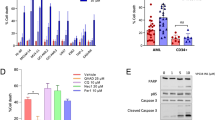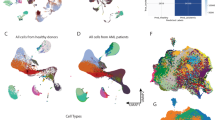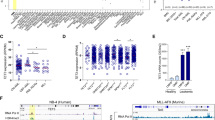Abstract
Acute myeloid leukemia (AML) is a malignant disease characterized by deregulated proliferation of immature myeloid cells. Constitutive activation of the phosphatidylinositol 3-kinase (PI3K)/AKT signaling pathway is frequently detected in approximately 50–70% of AML patients. The gene INPP5D encodes the SH2-containing inositol 5-phosphatase 1 (SHIP1), which is a negative regulator of PI3K/AKT signaling. After lentiviral-mediated gene transfer of INPP5D into CD34+ cells derived from AML patients (n=12) the granulocyte macrophage-colony stimulating factor (GM-CSF)-dependent proliferation was reduced in all samples analyzed (average 86%; range 72–93%). An enzymatically inactive form of SHIP1 (D672A) had no effect. In addition, SHIP1 reduced the autonomous proliferation of CD34+ cells from a patient with a secondary AML who had a very high peripheral blast count (300 × 109 l−1). These data show that SHIP1 can effectively block GM-CSF-dependent and autonomous proliferation of AML cells.
This is a preview of subscription content, access via your institution
Access options
Subscribe to this journal
Receive 6 print issues and online access
$259.00 per year
only $43.17 per issue
Buy this article
- Purchase on SpringerLink
- Instant access to full article PDF
Prices may be subject to local taxes which are calculated during checkout



Similar content being viewed by others
References
Rohrschneider LR, Fuller JF, Wolf I, Liu Y, Lucas DM . Structure, function and biology of SHIP proteins. Genes Dev 2000; 14: 505–520.
Luo JM, Liu ZL, Hao HL, Wang FX, Dong Z, Ohno R . Mutation analysis of SHIP gene in acute leukemia. J Exp Hematol 2004; 12: 420–426.
Gilby DC, Goodeve AC, Winship PR, Valk PJ, Delwel R, Reilly JT . Gene structure, expression profiling and mutation analysis of the tumour suppressor SHIP1 in Caucasian acute myeloid leukaemia. Leukemia 2007; 21: 2390–2393.
Luo JM, Yoshida H, Komura S, Ohishi N, Pau L, Shigeno K et al. Possible dominant-negative mutation of the SHIP gene in acute myeloid leukemia. Leukemia 2003; 17: 1–8.
Horn S, Endl E, Fehse B, Weck MM, Mayr GW, Jücker M . Restoration of SHIP activity in a human leukemia cell line downregulates constitutively activated phosphatidylinositol 3-kinase/Akt/GSK3β signaling and leads to an increased transit time through the G1 phase of the cell cycle. Leukemia 2004; 18: 1839–1849.
Metzner A, Horstmann MA, Fehse B, Ortmeyer G, Niemeyer CM, Stocking C et al. Gene transfer of SHIP-1 inhibits proliferation of juvenile myelomonocytic leukemia cells carrying KRAS2 or PTPN11 mutations. Gene Therapy 2007; 14: 699–703.
Sattler M, Verma S, Byrne CH, Shrikhande G, Winkler T, Algate PA et al. BCR/ABL directly inhibits expression of SHIP, an SH2-containing polyinositol-5-phosphatase involved in the regulation of hematopoiesis. Mol Cell Biol 1999; 19: 7473–7480.
Kalesnikoff J, Sly LM, Hughes MR, Büchse T, Rauh MJ, Cao LP et al. The role of SHIP in cytokine-induced signaling. Rev Physiol Biochem Pharmacol 2003; 149: 87–103.
Nyakern M, Cappelini A, Mantovani I, Martelli AM . Synergistic induction of apoptosis in human leukemia T cells by the Akt inhibitor perifosine and etoposide through activation of intrinsic and Fas-mediated extrinsic cell death pathways. Mol Caner Ther 2006; 5: 1559–1570.
Steelman LS, Bertrand FE, McCubrey JA . The complexity of PTEN: mutation, marker and potential target for therapeutic intervention. Expert Opin Ther Targets 2004; 8: 537–550.
Xu Q, Simpson SE, Scialla TJ, Bagg A, Carroll M . Survival of acute myeloid leukemia cells requires PI3 kinase activation. Blood 2003; 102: 972–980.
Horn S, Meyer J, Heukeshoven J, Schulze C, Li S, Frey J et al. The inositol 5-phosphatase SHIP is expressed as 145 and 135 kDa proteins in blood and bone marrow cells in vivo, whereas carboxyl-truncated forms of SHIP are generated by proteolytic cleavage in vitro. Leukemia 2001; 15: 112–120.
Acknowledgements
The excellent technical assistance of W Wegner, M Engel and A Düsedau is thankfully acknowledged. We thank L Naldini for the lentiviral vector system including the plasmids pRRL.PPT.CMV.GFPpre, pRSV-Rev, pMDLg/p and W Beyer for the plasmid pHCMV-VSV-G. This work was supported by grants from the Deutsche-Forschungsgemeinschaft to MJ and GWM (JU255/2-4 and JU255/2-5).
Author information
Authors and Affiliations
Corresponding author
Rights and permissions
About this article
Cite this article
Metzner, A., Precht, C., Fehse, B. et al. Reduced proliferation of CD34+ cells from patients with acute myeloid leukemia after gene transfer of INPP5D. Gene Ther 16, 570–573 (2009). https://doi.org/10.1038/gt.2008.184
Received:
Revised:
Accepted:
Published:
Issue date:
DOI: https://doi.org/10.1038/gt.2008.184
Keywords
This article is cited by
-
In silico mutagenesis-based designing of oncogenic SHP2 peptide to inhibit cancer progression
Scientific Reports (2023)
-
SHIP1, but not an AML-derived SHIP1 mutant, suppresses myeloid leukemia growth in a xenotransplantation mouse model
Gene Therapy (2017)
-
Pharmacological targeting of miR-155 via the NEDD8-activating enzyme inhibitor MLN4924 (Pevonedistat) in FLT3-ITD acute myeloid leukemia
Leukemia (2015)
-
Late-Onset Alzheimer’s Disease Genes and the Potentially Implicated Pathways
Current Genetic Medicine Reports (2014)
-
Expressional alterations in functional ultra-conserved non-coding rnas in response to all-transretinoic acid - induced differentiation in neuroblastoma cells
BMC Cancer (2013)



